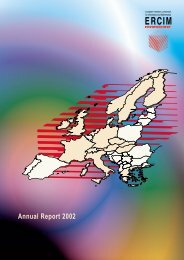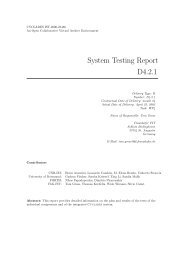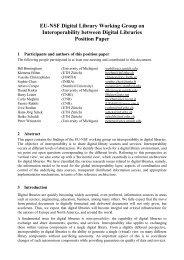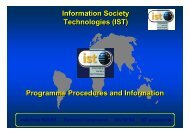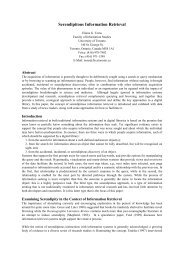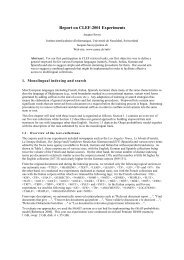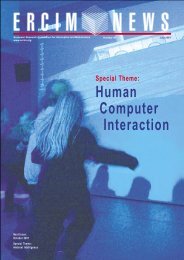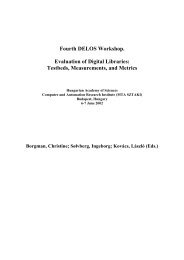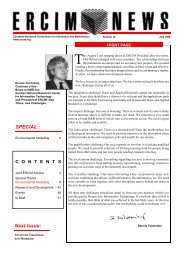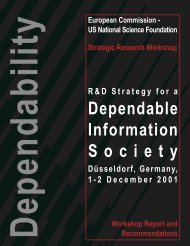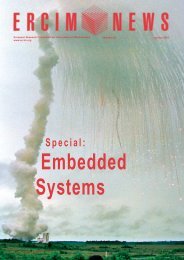Towards a Platform for Widespread Embedded Intelligence - ERCIM
Towards a Platform for Widespread Embedded Intelligence - ERCIM
Towards a Platform for Widespread Embedded Intelligence - ERCIM
You also want an ePaper? Increase the reach of your titles
YUMPU automatically turns print PDFs into web optimized ePapers that Google loves.
Figure 2: Extending SOA with interoperability enablers.<br />
system interworking. In the application<br />
layer, semantics and behaviours of services<br />
are reasoned upon and matched<br />
with the requested ones in order to<br />
decide their adequacy <strong>for</strong> a given user<br />
request. Second, semantic-rich interoperable<br />
service interaction enables services<br />
to cooperate and compose. In the<br />
middleware layer, support is provided<br />
<strong>for</strong> communication protocol and data<br />
type system interworking. In the application<br />
layer, semantics and behaviours of<br />
services are adapted and interworked to<br />
enable their seamless interaction.<br />
Prototypes of the related architectural<br />
components have been implemented.<br />
Materials with <strong>Intelligence</strong><br />
by Simon Dobson and Kieran Delaney<br />
Per<strong>for</strong>mance evaluation shows that our<br />
solutions comply with the requirements<br />
of the pervasive computing environment.<br />
We are now in the process of integrating<br />
them to offer an instance of the<br />
overall architecture. We are further<br />
studying extensions to the architecture to<br />
effectively exploit beyond third generation<br />
networks and related multi-radio<br />
wireless handheld devices; this will<br />
expand the scope of our interoperability<br />
solution to further cover radio and network<br />
heterogeneity.<br />
Enabling the pervasive computing vision<br />
has given rise to tremendous research<br />
Sensor networks are the key enabling technology <strong>for</strong> building systems that adapt<br />
autonomously to their environment, without direct human intervention. Most<br />
sensor networks operate in free air, but research being conducted in Ireland,<br />
between the School of Computer Science and In<strong>for</strong>matics at UCD Dublin and the<br />
Centre <strong>for</strong> Adaptive Wireless Systems at Cork IT, is starting to explore the tools<br />
and techniques we need in order to build 'augmented materials' which combine<br />
sensing, actuation and processing into the fabric of built objects.<br />
Embedding sensing into a physical substrate<br />
has a number of attractions. Each<br />
sensor package can sense a number of<br />
local variables such as the stress on the<br />
material, its orientation in space, its<br />
proximity to other materials etc.<br />
Combine these sensors into a network<br />
and we can construct a global view of the<br />
material and its relationships to the real<br />
world. Add processing and we have the<br />
potential to build materials that "know<br />
themselves", in some sense, and which<br />
SPECIAL THEME: <strong>Embedded</strong> <strong>Intelligence</strong><br />
over the last decade. In particular, various<br />
supporting software infrastructures<br />
have been proposed, some enabling<br />
semantic awareness <strong>for</strong> services, others<br />
dealing with middleware interoperability.<br />
Our contribution lies in the integrated<br />
treatment of service interoperability,<br />
from the application to the middleware<br />
layer. Our solution has further<br />
been designed to be lightweight and thus<br />
can be supported in most pervasive environments,<br />
not requiring the presence of a<br />
dedicated server. As a result, true open,<br />
pervasive computing environments are<br />
enabled - integrating and composing in<br />
an ad hoc fashion the most appropriate<br />
networked services in order to deliver<br />
rich applications to users, independently<br />
of heterogeneous underlying software<br />
technologies and semantic representations.<br />
Our research is conducted as part of the<br />
European IST Amigo and Plastic projects<br />
and industrial collaborations with<br />
Alcatel and Thales.<br />
Links:<br />
ARLES site: http://www-rocq.inria.fr/arles/<br />
Please contact:<br />
Valerie Issarny, Nikolaos Georgantas,<br />
INRIA, France<br />
Tel: +33 1 39 63 57 89<br />
E-mail: Valerie.Issarny@inria.fr,<br />
Nikolaos.Georgantas@inria.fr<br />
can react in ways that are far more<br />
sophisticated than are possible with simpler,<br />
'smart' materials.<br />
If this all sounds a bit abstract, imagine a<br />
person with a broken leg who is wearing<br />
a plaster cast. For a physiotherapist, the<br />
challenge is to make the person take adequate<br />
exercise to stimulate the break,<br />
while at the same time stopping them<br />
from attempting too much and risking<br />
further damage. As the physiotherapy<br />
programme changes over time and in<br />
conjunction with on-going assessment of<br />
<strong>ERCIM</strong> News No. 67, October 2006 37



